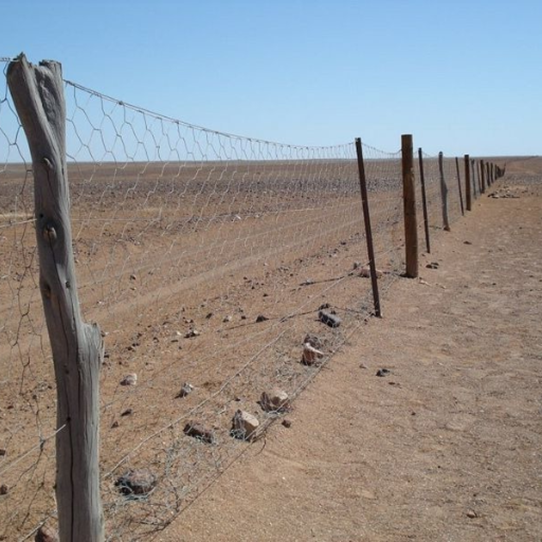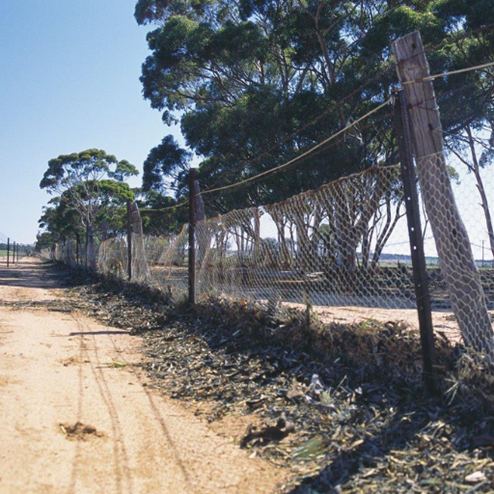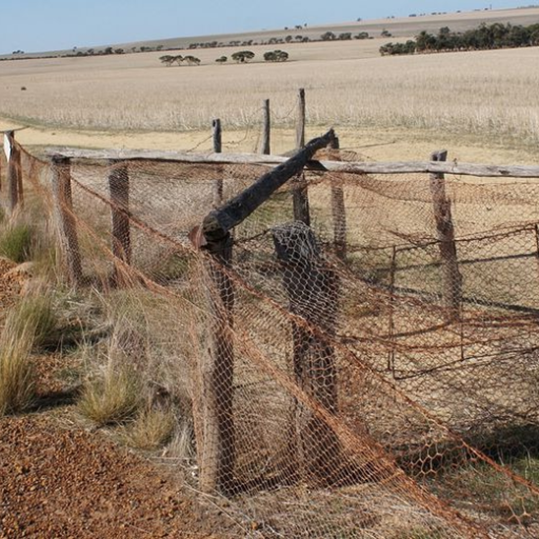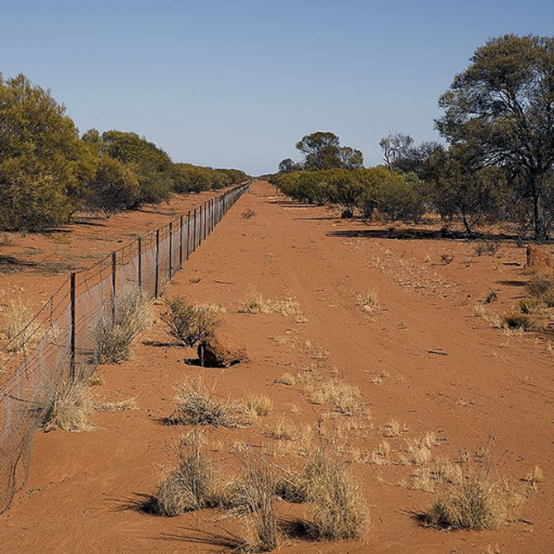-
 Liu
Hi there! Welcome to my shop. Let me know if you have any questions.
Liu
Hi there! Welcome to my shop. Let me know if you have any questions.
Your message has exceeded the limit.

Rabbit-Proof Fence in Australia: Effective Solutions for Keeping Rabbits Out
2025-10-06 23:08:53
Rabbits are seemingly harmless and indeed cute, yet all over Australia, they have become an environmental and agricultural nightmare pest. Having been introduced in the 19th century, within a short span of time, thanks to rapid population growth, they damaged crops to such an extent that ecosystems were altered, threatening the existence of native species, thereby forcing the country to find ways to contain them. One of the large-scale and iconic solutions would have to be the Rabbit-Proof Fence, a daunting architectural feat designed to curtail the movement of these invasive creatures into valuable farmland. This article subjects the history of the rabbit-proof fence, its purpose, and its success to scrutiny while hinting at more contemporary approaches that have been developing in this infuriating rabbit overflow. Prepare yourself to learn about how Australia addressed one of the continent's most vexing environmental challenges. Find more info now.
Understanding Rabbit Issues in Australia

Rabbits were introduced to Australia in the 18th century and soon developed a reputation as one of the most damaging invasive species. Without natural predators and with a high rate of reproduction, the rabbit populations multiplied quickly, causing havoc everywhere, including on crops, native vegetation, and soil stability. This situation adversely affected agriculture, hindered the food competition, and created more adverse conditions for the native species to compete for habitats. Several efforts have been made to control the rabbit population, including fencing, hunting, and the promotion of biological controls such as the myxoma virus and the rabbit calicivirus, which have experienced varying degrees of success over time. Rabbit population management remains a matter of great importance for conservation and agricultural sustainability in Australia.
The Impact of Rabbits on Australian Ecosystems
The widespread introduction and spread of rabbits across Australia have had profound ecological and economic implications. Below are five major impacts described with data observations:
Loss of Vegetation Cover
Rabbits feed on huge quantities of native vegetation and contribute to soil erosion and desertification. Some studies showed that annual consumption by rabbit populations of native plants could range up to 100 kilograms per hectare, leaving the lands bare and unable to regenerate.
Decline of Biodiversity
Rabbits have caused a significant and drastic decline of native species through competition with native herbivores and habitat destruction. For example, species such as the greater bilby and bandicoot have been severely affected, with certain populations driven to the brink of extinction.
Reduction of Agricultural Productivity
Rabbits cost the Australian agricultural industry significantly by consuming crops, reducing the amount of pasture for livestock, and damaging infrastructure, such as fences. It has been estimated that the infection causes losses upwards of $200 million annually.
Change of Soil Quality
Heavy grazing by rabbits degrades the soil, reducing its ability to hold moisture and support vegetation growth, thereby impeding the ecosystem's sustenance.
Weed Dispersion
Rabbits aid in the spread of invasive plant species by grazing on native plants, thereby facilitating the growth of invasive species, thus disturbing the ecological balance.
Having said that, impactal mitigations continue to focus on managing rabbit populations along with habitat restoration to aid ecosystem recovery.
Common Rabbit Species in Australia
European Rabbit (Oryctolagus cuniculus)
The European rabbit is the widely distributed and most considered species of rabbits in Australia. Introduced in the mid-19th century into Australia, it soon multiplied rapidly and became a great nuisance. It is mainly the European rabbits that have caused extensive damage to the Australian environment, being accountable for overgrazing, erosion, and loss of biodiversity. Estimates say that there are about two hundred million European rabbits in Australia by today, even after so many control measures, such as fencing, baiting, and biological controls, namely the myxomatosis virus.
Feral Domestic Rabbits
These are domestic rabbits that escape or are released into the wild and adapt to it. Although these rabbits share many traits with Oryctolagus cuniculus, feral domestic rabbits typically exhibit a wider variety of fur colors and patterns. Commonly local rather than widespread, these domestic rabbit types contribute to localized environmental degradation.
Management efforts on populations continue to pose significant challenges to Australian conservationists, with ongoing research aimed at discovering new ways to mitigate their impact on fragile ecosystems.
Why a Rabbit-Proof Fence is Necessary
The rabbit-proof fence in Australia remains one of the most significant measures in controlling and mitigating the environmental and agricultural impacts of rabbits. Introduced around the 19th century, European rabbits soon became one of the most invasive animal species in Australia, and it is estimated that a single pair of rabbits under favorable conditions can give rise to more than 180 descendants within 18 months. By the latter half of the 20th century, there were hundreds of millions of rabbits going across much of the continent.
Rabbits kill and destroy fragile ecosystems by overgrazing, which causes soil erosion along with the loss of native vegetation that many of the other species depend on for survival. It has recently been reported that the agricultural damage caused by rabbits nationwide exceeds $200,000,000 annually, making it imperative to implement effective control measures. The rabbit-proof fence was initially built in the early 1900s. It was designed to protect prime farmland and ecosystems in Western Australia by physically preventing rabbits from moving further westward.
More recent studies indicate that the fence remains relevant, and its effectiveness is even enhanced when used in conjunction with a suite of other rabbit controls, including selective poisoning, biological control agents such as myxoma virus, and habitat management. With a total length exceeding 2,000 miles (3,256 kilometers) in its original inception, some parts of the fence remain in good repair and are actively being utilized in conservation efforts. Even after more than 100 years of existence, the rabbit-proof fence stands to remind us of just how invasive species continue to cause problems and how immediately we need to come up with clever solutions to try to curb their last.
Types of Rabbit-Proof Fences

Rabbit-proof fences come in various types and can be classified by design, function, and effectiveness against invasive species. These fences protect liminal agricultural lands, native vegetation, and other ecosystems from the devastating effects of rabbit populations. Here are the major types of rabbit-proof fences and their features:
1. Standard Rabbit-Proof Fences
Standard rabbit-proof fences are typical fences and have been in use ever since the first-ever original Rabbit Proof Fence was built in Australia. These fence types typically comprise a strong wire mesh with small interwoven patterns so that rabbits may not pass through them. They stand roughly 3 to 4 feet taller, as they would have been too much of an easy target for rabbits jumping over them.
Material: Galvanized wire mesh
Cost: Roughly between $2 to $4 per foot, depending on materials used and labor
Lifespan: 20 to 30 years with proper maintenance
2. Electric Rabbit-Proof Fences
Among the recent methods for controlling rabbits, electric fences are becoming increasingly popular. These fences deliver an electric shock, mild enough not to cause harm, upon contact. Typically, these fences are paired with standard designs to create a hybrid combination that is more durable and effective.
Voltage: Usually about 4,000 to 5,000 volts, which is safe yet deterring for rabbits
Cost: $3 to $6 per foot, on account of the electrical installation and wiring
Recommendation: Best used where rabbit activity is everyday or there is a very severe infestation
3. Buried Rabbit-Proof Fences
Buried rabbit-proof fences incorporate an additional dimension below the ground to prevent rabbits from digging underneath the wire mesh. The wire mesh is buried between 6 and 12 inches (15 and 30 cm) below the ground, and that works well in areas where digging causes problems.
Burial Depth: 6 to 12 inches (15 to 30 cm)
Installation: Needs more labor and planning
Applications: For farmlands and nature reserves where digging is common
4. Portable Rabbit-Proof Fences
Portable fencing implies flexibility. Lightweight to carry, it can be quickly erected, dismantled, or moved as needed: a feature very useful in temporary situations, such as protecting seasonal crops or smaller garden areas.
Material: Polyethylene mesh and reinforced steel
Price: $1.50-$2.50 per linear foot
Advantages: Easy and fast to set up and move around
Effectiveness and Maintenance
The maintenance culture decides the effectiveness of rabbit-proof fence designs. Regular inspections to repair damaged fence sections, remove vegetation buildup, and test electrical systems to ensure they are functioning at full capacity are highly recommended practices for achieving greater long-term success. Studies have shown that the population of rabbits in protected zones can be reduced below 90% when well-maintained fences are applied, hence significantly decreasing agricultural losses and environmental degradation.
By integrating time-tested and modern-day concepts for rabbit fences, these defenses take a step further in regularly chasing back troublesome rabbit populations in affected areas worldwide.
Materials Used for Rabbit-Proof Fences
Rabbit-proof fences are actually very sturdy in the area they are built, Weather-wise and to deter invasive rabbit populations. Key materials commonly used for building such fences are:
Wire Mesh Fencing
Most rabbit-proof fences are made of wire mesh. These meshes are typically made of galvanized steel, which prevents rusting and offers enhanced longevity. The mesh should not have any holes larger than 1 inch (2.5 cm) to allow the rabbits to pass through. Research has proven that a galvanized steel fence can last 20 to 30 years with minimal maintenance, making it a cost-efficient choice for long-term purposes.
Underground Barrier
These act as a deterrent for underground burrowing by these animals. The wire mesh is usually buried 6-12 inches (15-30 cm) below the ground surface. Some fences use heavy metal, concrete slabs, or even iron sheets as another level of digging deterrent.
Electric Wiring
A modern rabbit-proof fence even has a low-voltage electric wire system included as a further deterrent. This wire is placed strategically near the base of the wall, powered by solar or battery systems. With electric wiring applied to conventional mesh fencing, breaches have been reduced by up to 50% in research studies.
Posts and Frames
Wood or metal posts support the fencing structure. Metal posts, especially those made of steel or aluminum, are typically preferred due to their durability and resistance to wear from environmental factors. Wooden posts are used that are less durable and treated for rot and termite attack.
Anti-Corrosion Coatings
To ensure longevity, many rabbit-proof fences are given anti-corrosion coatings, which protect the structure from moisture and other elements that cause degradation. Data shows that materials, when treated, remain functional 40% longer than those left untreated.
Thus, these materials and installation practices keep rabbit-proof fencing a tried and tested solution for safeguarding agricultural lands and ecosystems against invasive species. Advancements in sustainable materials and technologies elevate the fight to higher levels of efficiency and effectiveness worldwide.
Design Features of Effective Rabbit Fences
Appropriate Fence Height
The studies suggest building a fence of at least 36 inches in height to prevent jumping. In areas with large rabbit populations, a taller fence may be necessary.
Buried Fence Base
Good rabbit fences include a buried mesh base, 6 to 12 inches deep, so that rabbits cannot dig beneath the fence. There is evidence that such fences reduce burrowing incidents that breach the wall by 80%.
Small Mesh Size
Small openings in the wire mesh (generally no larger than 1 inch by 1-inch) would prevent smaller rabbits from passing through the fence.
Durable Rust-Proof Materials
Top-of-the-line fencing materials are made from galvanized steel or coated wires, allowing them to withstand weather and other degrading agents. Tests have shown that galvanized steel fences may last 50% longer under harsh conditions than non-galvanized ones.
Angled or Curved Tops
Some designs will have the top angled or curved outward to make climbing tricky for the more agile rabbit species. This would further improve the usefulness of the fence in areas where ramming is noted.
Cost Considerations for Building a Rabbit-Proof Fence
An application of proper budgeting and development of feasible budgets must be done, considering the several cost factors that go into the construction of a highly effective fence against rabbits, and the wall should be durable. Key factors to consider in costing:
Cost of Materials
Primary setting materials, such as galvanized steel, chicken wire, or mesh, are defense materials that will vary widely in cost depending on the quality and durability. For example, galvanized steel can cost anywhere from $1.50 to $3.00 per square foot, while a bare chicken wire might cost between $0.50 and $1.00 per square foot.
Height and Length of Fence
The total height and length of the fence will require a significant amount of raw materials and labor, while also putting pressure on the overall budget. A standard rabbit-proof fence may be built from 2 to 3 feet high, whereas it may cost between $100 and $200 per 50 linear feet, depending on its various specifications.
Installation Labor Costs
Depending on the professional installation, the installation can take a significant toll on your budget. Rates for labor, depending on the region and expertise, may vary, with the highest average ranging from $25 to $50 per hour. Hiring well-experienced professionals who can ensure the proper installation will only help in raising the budget.
Additional Features
Cost increases also occur when angled tops, buried fencing to prevent animals from digging, or reinforced posts are introduced. Reinforced posts may hike the costs by about $10 to $20 for each post installed, while burying of the fence material can add anywhere from $1 to $2 per linear foot, depending on the soil conditions.
Maintenance Costs
Maintaining includes upkeep, repair, or replacement of rusted sections, thereby increasing long-term costs. Maintenance costs may range from $50 to $150 per annum, with an increase in price in wet or harsh climates.
Having factored those in, you can proceed with drawing a suitable budget for planning and building a sturdy rabbit-proof fence.
Building and Maintaining a Rabbit-Proof Fence

Choosing the Proper Materials
Use durable materials such as galvanized steel mesh or welded wire with a small mesh size (1 inch or less) so that rabbits can't wriggle through. The materials should be as UV-resistant as possible to minimize deterioration over time.
Fence Height and Depth
Ensure the fence is at least 2 to 3 feet tall above the ground to prevent rabbits from jumping over it. Additionally, the fence should be buried 6 to 12 inches below ground level to discourage burrowing.
Securing the Fence Edge
Create an outward bend at the bottom edge of the fence underground to form a dig guard, which prevents further tunneling under the wall by rabbits.
Regular Check-ups
Inspect for holes, rust, and signs of wear and tear every week. Repair damage as it occurs to ensure the fence's perfection.
Vegetation Management
Clear the overgrown grass, debris, or vegetation around the base of the fence. This will stop the rabbits from using the area as an escape route and will also lessen the damage to the wall.
If all these steps are fully followed, you can be assured of having an effective and long-lasting rabbit-proof fence, thus providing excellent protection for your garden or property from rabbit invasions.
Step-by-Step Guide to Constructing a Rabbit Fence
Step | Key Point |
1. Gather Materials | Collect wire mesh, posts, staples, and tools. |
2. Mark Fence Line | Use string or markers to outline the area. |
3. Dig a Trench | Create a trench 6-8 inches deep around the edges. |
4. Install Fence Posts | Place posts 2-2.5 meters apart, 30cm deep. |
5. Attach Tension Wire | Secure the wire at the top and bottom for stability. |
6. Attach Mesh | Secure mesh to posts, ensuring it is taut. |
7. Create Burrow Barrier | Bend mesh into an "L" shape, bury 6 inches. |
8. Secure Mesh Edges | Use staples or pegs to fix mesh firmly. |
9. Cover Trench | Backfill trench with soil or mulch. |
10. Inspect and Finish | Check for gaps, reinforce weak spots. |
Maintenance Tips for Longevity of Rabbit-Proof Fences
Regular maintenance is needed to keep the rabbit-proof fence in good repair over time. The following are five more tips you can follow to keep the wall while retaining its functionality and durability:
Regular Inspection
Along the entire fence, you should regularly inspect for any wear and tear or holes made by weather, animals, or humans. Any repair requirement should be addressed immediately to prevent further damage.
Reinforcing Weak Points
Check particularly where the fence meets the ground. This is the point where rabbits are most likely to dig or chew through. If these areas seem weak, reinforce them with extra mesh or stakes.
Avoiding Rust
If you make your fence out of metal, make sure that you apply rust-inhibiting paint or use galvanized materials. This prevents rusting in a humid or rainy climate.
Keep an Eye on Trees and Shrubs
Ensure that no trees or shrubs nearby are pressing against the fence. Growing branches will exert pressure on it, causing damage over time, while falling debris will weaken its structure.
Prepare for Seasonal Weather
Heavy snowfalls or strong winds tend to come with the seasons. When such weather hits, your fence will need extra support to prevent it from sagging or being damaged.
By following these five maintenance guidelines, your rabbit-proof fence will enjoy a longer lifespan, ensuring it remains intact for many years of protection.
Common Mistakes to Avoid When Installing a Rabbit Fence
Mistake | Key Point |
1. Incorrect Fence Depth | Not burying fence deep enough for burrowers. |
2. Poor Material Selection | Using weak or unsuitable materials. |
3. Skipping Pest Assessment | Ignoring rabbit behavior and movement patterns. |
4. Improper Mesh Tension | Loose mesh allows gaps for rabbits to enter. |
5. Neglecting Maintenance | Failing to inspect and repair damages. |
6. Inadequate Post Spacing | Posts too far apart reduce fence stability. |
7. Overlooking Local Rules | Ignoring regulations for fencing installation. |
8. No Burrow Barrier | Missing underground "L" shape to stop digging. |
9. Uneven Installation | The fence is not level or appropriately aligned. |
10. Skipping Dry Fitting | Not testing components before permanent setup. |
Legal and Environmental Considerations

A proper understanding of legal and environmental issues is required for the installation of rabbit-proof fences. Special regulations may govern fence construction in your area, primarily when such fences are intended to curtail wildlife activity. For instance, in some jurisdictions, fences are subjected to local zoning laws that may prescribe their height, materials, and even placement. Some areas may also require permits for fencing work, particularly if the area is deemed ecologically sensitive. It is best to check with the local government or municipality immediately to determine if any requirements apply.
In environmental terms, a fence may have an impact on the local ecosystem. If poor design is implemented, the wall may well hinder the natural movements of other wildlife or block migration routes for particular species, resulting in unintended consequences of the fence. Hence, those designs where incidental damage is kept to a minimum are preferred, such as wildlife-friendly fence materials or small openings at the bottom for smaller, non-nuisance animals.
Materials used are another vital consideration. Use materials like untreated wood or recycled metal that are sustainable and non-toxic to minimize the environmental impact. Similarly, appropriate disposal of old fencing should be given priority, preventing the pollution of an area or the destruction of a habitat for a species. There have been reports lately stating that the choice for environmentally friendly fencing options has been soaring the market, with the focus shifting on the materials that are cheap and biodegradable towards global sustainability.
Finally, look at the long-term effects that the fence will have on the surrounding environment. Do not use toxic paints or coatings that will contaminate the soil and hurt plant or animal life. Maintaining the property, such as by clearing vegetation buildup without the use of pesticides, ensures that efforts to safeguard your property will not ultimately harm the broader ecosystem. Being proactive in recognizing these legal and environmental factors will help you stay compliant and support nature conservation.
Regulations Surrounding Rabbit-Proof Fences in Australia
The ingenious fences have been crucial in preventing the trespassing of introduced European rabbits, which were introduced in the 19th century and very quickly became a pest in agriculture. Such fences, including the State Barrier Fence, are regulated by different state legislations to ensure that they are well-maintained and serve to protect agricultural and natural areas.
Key Regulations and Guidelines
Construction and Maintenance - In most cases, especially in Western Australia, various laws require farmers or landowners to erect and properly maintain a barrier fence against rabbits, as exemplified by the Biosecurity and Agriculture Management Act 2007. It should be placed in such a way as to comply with standards relating to the height of the fence, the type of netting, and clearance above ground to prevent rabbits from digging underneath it.
Coordinated Community Programs - Aspects of pest control are addressed through community members working together to install and maintain rabbit-proof fencing. Recent data indicate that the collective effort has led to an 85% decline in rabbit numbers in certain areas.
Environmental Elements - Current regulations stress the need for eco-friendly solutions that uphold biodiversity. Thus, the fences are not expected to inhibit the movement of native wildlife and should adhere to conservation laws, such as guaranteeing wildlife corridors for their safe passage.
Recent Developments
Further examples highlighting investment in this infrastructure underscore the importance of preventing the rise in rabbit populations from destroying crops and native vegetation. Government funds have been allocated for the maintenance and upgrading of the State Barrier Fence, with a recent investment of $7 million. The use of new technology, such as GPS mapping, is also on the rise in monitoring the fence status and tracking rabbit movements.
A lack of development would spell disaster, so by adhering to laws and adopting an innovative working approach, Australia continues to mitigate the social and economic impact posed by this invasive species, the rabbits.
Environmental Impact of Fencing
Coming into arms against invasive species, fences have a number of implications on the environment to be considered. Five significant impacts of fencing have been elaborated upon and data are presented.
Fragmentation of Habitats
Fences can disrupt ecosystem processes by dividing habitat areas, preventing wildlife, whether migrating, feeding, or drinking, from moving freely. The study indicated that fencing has restricted the movement of over 40% of large herbivore species in certain protected areas.
Impact on Native Species
While fences serve to control invasive species like rabbits, they may unintentionally harm native species, as some smaller mammals or ground-nesting birds get trapped by or are excluded from critical habitats that are fenced off for pest control.
Altered Predator-Prey Dynamics
By dividing the landscape, fencing might also divide interactions of predator-prey relationships. This situation could lead to the overpopulation of certain species within the fenced areas, necessitating environmental adjustments.
Disturbances Caused by Maintenance
The maintenance work and repairs to large-scale fences, such as the State Barrier Fence, may also cause soil erosion and loss of vegetation along the fence line. It is estimated that these operations alone account for up to 5% of degradation in the surrounding natural environment.
Expense and Resource Consumption
The materialization of large-scale fences requires substantial amounts of natural resources, such as timber, steel, and water, which could have been utilized more sustainably elsewhere. The $ 7 million investment in the State Barrier Fence itself gives an indication of the cost involved in these measures.
Becoming aware of these impacts is crucial to ensure that fencing efforts are implemented in ways that, at the very least, achieve ecological balance and conservation."
Community Initiatives for Rabbit Control
I believe that rabbit control in community projects should focus on cooperation and sustainability aspects. Efforts to engage local groups in habitat management, trapping, and the use of targeted exclusion fencing can significantly contribute to reducing rabbit populations. Awareness programs and educational initiatives can help communities understand the adverse effects of rabbits on ecosystems and promote humane control methods. We can work together to find long-term solutions that address every concern, from ecological conservation to community needs.
Frequently Asked Questions (FAQ)
What is the rabbit-proof fence in Australia?
The rabbit-proof fence, also known as the state barrier fence, is a massive barrier erected in Western Australia to prevent wild rabbits from entering, following their introduction in the 1880s. Work on the original wall commenced in 1901 and was completed in 1907, making it one of the longest unbroken fences in the world, measuring over 3,256 kilometers.
How does the rabbit-proof fence assist in the control of the rabbit populations?
The fence prevents the destruction of agricultural land from the impact of rabbits, considered an invasive species and agricultural pest. By hindering their movements, the fence enables keeping the rabbit population in check at a level where rabbits could inflict significant damage on crops and pasture.
Where does the rabbit-proof fence run?
The rabbit-proof fence runs from the north to the south in Western Australia, on the eastern side near Perth, extending toward the state border with South Australia. It consists of three fences named fence no. 1, fence no. 2, and fence no. 3, placed strategically to keep rabbits smaller and further west.
What materials have been used for constructing the rabbit-proof fence?
The rabbit-proof fence was constructed using wire netting to deter rabbits from burrowing or climbing. Regular anti-erosion inspection and maintenance have been carried out to ensure the wall is effective in keeping rabbits away from fertile agricultural lands.
When is the rabbit-proof fence inspected?
A group of boundary riders patrols the fence to ensure that the site of the wall is inspected and remains intact. This maintenance is crucial in preventing breaches that would allow rabbits to enter from previously protected areas.
What challenges does the rabbit-proof fence face today?
The rabbit-proof fence is currently challenged by natural erosion, weather events, and periodic repairs, as it is damaged by vermin and wildlife. The presence of animals like emus may also interfere with maintaining an efficient fence line.
How effective has the rabbit-proof fence been since its construction?
Since the fence was erected in 1907, the rabbit-proof wall has played a significant role in drastically reducing the number of rabbits in Western Australia's agricultural lands. It does not deny that rabbits have been detected west of the line, but the fence has largely prevented their widespread invasion into areas of important farming.
What is the significance of the rabbit-proof fence in terms of history?
The rabbit-proof fence is not only an essential agricultural barrier but also a piece of Australian history that tells the story of early 20th-century attempts to control invasive species. The fence was constructed following a royal commission that investigated the growing concerns about rabbits affecting the landscape and farming methods.
Tags: Imitation Bamboo Fence


